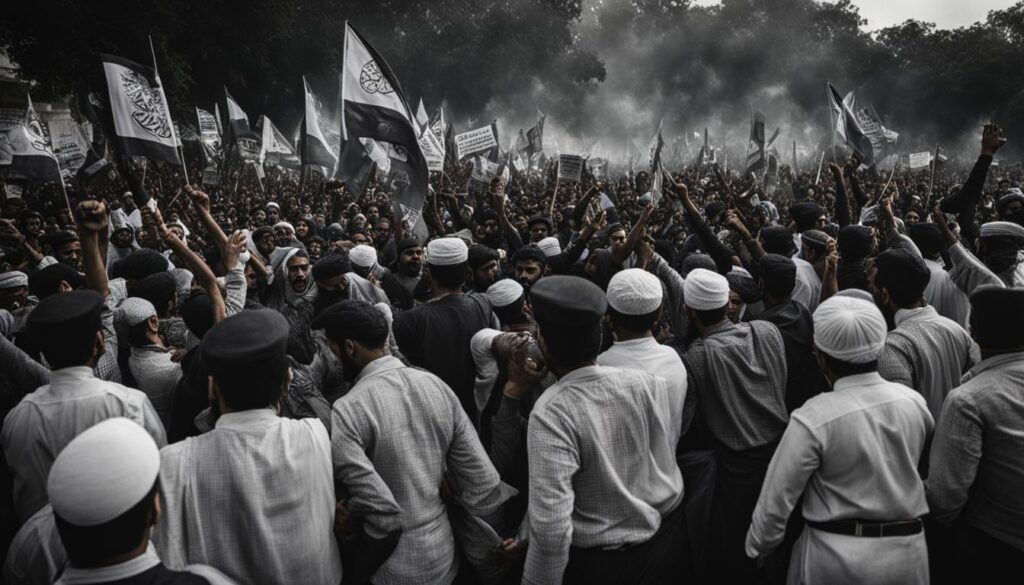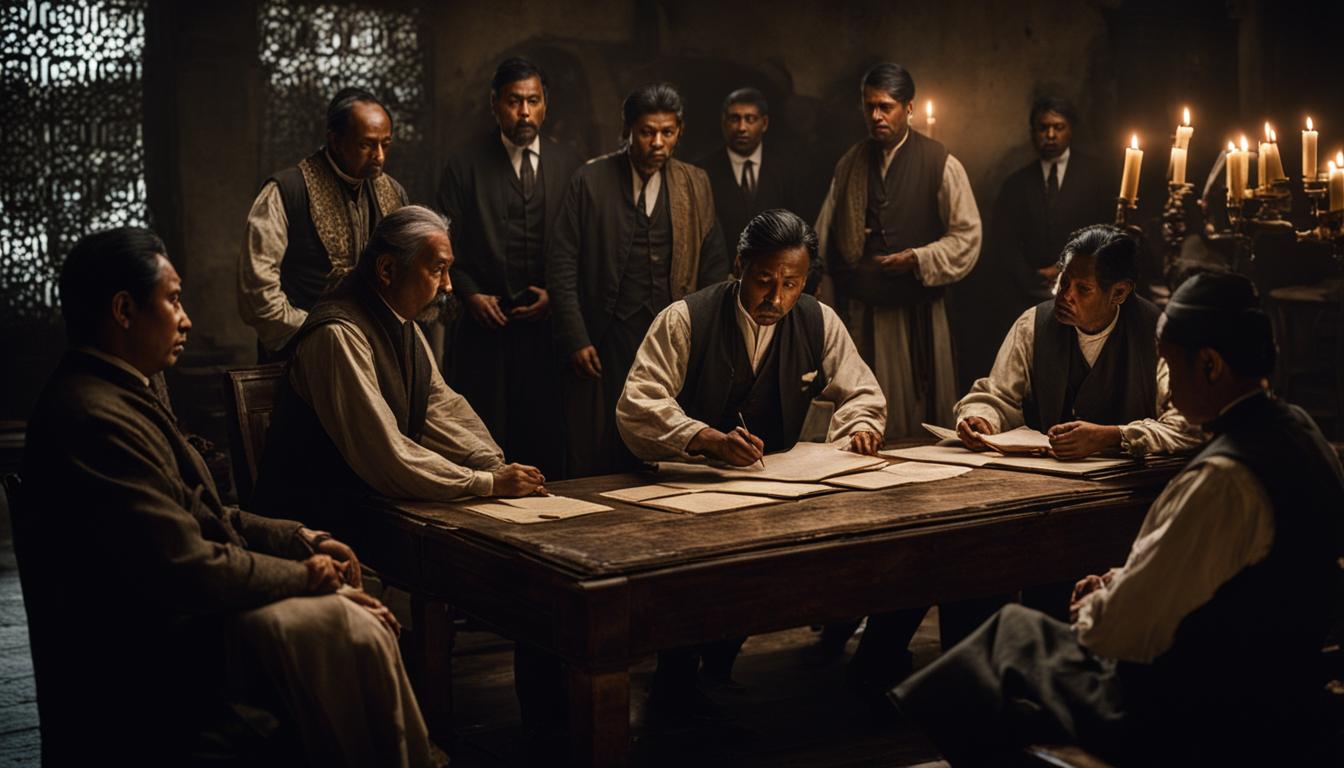The All-India Muslim League, an influential political party in British India, was established on December 30, 1906, during the annual meeting of the All India Muslim Education Conference in Dacca, British India (now Dhaka, Bangladesh). This historic event took place with the aim of safeguarding the interests of the Muslim population in the region, amidst growing concerns of Hindu opposition to the partition of Bengal.
Proposed by Khwaja Salimullah and unanimously passed, the motion to create the All-India Muslim League marked its official formation. The party’s primary objective was to secure Muslim representation and provide a platform for addressing the challenges faced by the Muslim community in British India.
Key Takeaways:
- The All-India Muslim League was founded on December 30, 1906, in Dacca, British India (now Dhaka, Bangladesh).
- Its establishment aimed to protect the interests of Muslims in British India and address Hindu opposition to the partition of Bengal.
- Khawaja Salimullah proposed the motion for the party’s formation during the annual meeting of the All India Muslim Education Conference.
- The All-India Muslim League focused on securing Muslim representation in politics and advocating for the rights and aspirations of the Muslim community in British India.
- The formation of the All-India Muslim League was a significant step towards shaping the political landscape of the region.
The Origins and Expansion of the Muslim League
The Muslim League traces its history back to its formation as an elitist organization. However, it underwent a significant transformation that led to its expansion and popularity among the Muslim masses in the late 1930s.
In the 1930s, the influential philosopher Sir Muhammad Iqbal espoused the idea of uniting the four provinces in North-West British India. This vision aligned with the Muslim League’s belief in the two-nation theory, strengthening their conviction for a separate nation-state.
During the 1940s, the Muslim League emerged as a driving force behind the division of India along religious lines. Their efforts led to the creation of Pakistan as a Muslim state in 1947.
This image represents the historical significance of the Muslim League’s origins and the subsequent expansion that played a pivotal role in shaping the political landscape of the Indian subcontinent.
The Dissolution and Successors of the All-India Muslim League
After the Partition of India in 1947 and the establishment of Pakistan, the All-India Muslim League was formally disbanded in India. It was succeeded by the Pakistan Muslim League, which eventually split into several political parties. In Bangladesh, the Muslim League was revived in 1976 but has been reduced in size and significance in the political arena. In India, a separate independent entity called the Indian Union Muslim League was formed and continues to have a presence in the Indian parliament.
The dissolution of the All-India Muslim League marked a turning point in its history, as it paved the way for the formation of new political entities in the aftermath of India’s partition. The Pakistan Muslim League emerged as the dominant political force in the newly established country of Pakistan, advocating for the rights and interests of Muslims. However, over time, the party splintered into various factions, each with its own agenda and leadership.
In Bangladesh, the revival of the Muslim League in 1976 aimed to provide a platform for Muslim representation in the political landscape. However, its influence and significance have waned over the years, with other parties gaining more prominence.
In India, the Indian Union Muslim League emerged as a separate entity, representing the interests of Muslims within the Indian parliament. The party has maintained a presence in Indian politics, advocating for the rights and welfare of Indian Muslims.
The successors of the All-India Muslim League continue to shape the political landscape in their respective nations, albeit with varying degrees of impact and influence. While the Pakistan Muslim League has experienced internal divisions and factionalism, the Indian Union Muslim League remains an active participant in Indian politics. The Muslim League’s history and formation have left a lasting legacy, as its successors strive to uphold the interests of Muslims in their respective countries.
The Role of the Punjab Muslim League
The Punjab Muslim League played a significant role in the formation and expansion of the All-India Muslim League. Muslim leaders from Punjab, including Sir Mian Muhammad Shafi, Mian Fazl-i-Hussain, and Abdul Aziz, were instrumental in establishing the powerful Punjab Provincial Muslim League. This branch of the Muslim League, formed in 1907, advocated for Muslim rights and representation in Punjab.

Muslim League’s Support and Opposition
The All-India Muslim League encountered both support and opposition throughout its history. One significant instance of support came during World War II when the Congress party protested India’s involvement without consulting the Indian people. In contrast, the Muslim League chose to support the British war efforts during this time. However, their cooperation with the British in this matter led to opposition from certain factions within the Indian National Congress.
Additionally, the Muslim League faced opposition due to its stance on separate electorates and reserved seats during the negotiations surrounding the Indian Councils Act. These policies were met with resistance, raising concerns within the political landscape.

In the face of both support and opposition, the Muslim League navigated through challenges while striving to safeguard the interests of the Muslim community in British India. The league’s journey intertwined within the complex dynamics of Indian politics during the pre-independence era.
Conclusion
The All-India Muslim League, established in 1906, has played a pivotal role in the political history of British India. With the aim of safeguarding Muslim representation and protecting Muslim interests, the Muslim League emerged as a force to reckon with, countering the Hindu opposition. What initially began as an elitist organization transformed into a popular movement advocating for the creation of a separate nation-state – Pakistan.
Following the Partition of India, the Muslim League officially disbanded in India. However, its legacy lived on through the establishment of various political parties in Pakistan. The Muslim League’s influence on modern politics and its instrumental role in the formation of Pakistan cannot be overstated.
The All-India Muslim League’s formation marked a significant milestone in the struggle for Muslim rights and representation. Its growth from a small group to a nationwide movement is a testament to the power of collective action. The Muslim League’s impact on the political landscape of British India and its lasting legacy continues to shape the region today.
In conclusion, the Muslim League’s journey from its establishment to the creation of Pakistan underscores the importance of voicing and protecting the rights and interests of minority communities. It remains an essential chapter in the history of South Asia and serves as a reminder of the power of unity in the face of adversity.
FAQ
When was the All-India Muslim League formed?
The All-India Muslim League was founded on December 30, 1906 in Dacca, British India (now Dhaka, Bangladesh) during the annual meeting of the All India Muslim Education Conference.
Why was the Muslim League established?
The Muslim League was established to protect the interests of Muslims in British India and to secure Muslim representation in the political landscape.
Who proposed the motion to create the Muslim League?
The motion to create the political party was proposed by Khwaja Salimullah during the annual meeting of the All India Muslim Education Conference.
What was the goal of the Muslim League?
The main goal of the Muslim League was to secure Muslim representation and address the Hindu opposition to the partition of Bengal.
When did the Muslim League become a popular organization?
The Muslim League began mobilizing the Muslim masses and turned into a popular organization in 1937.
Who played a significant role in the formation of the All-India Muslim League?
The Punjab Muslim League, led by influential figures such as Sir Mian Muhammad Shafi, Mian Fazl-i-Hussain, and Abdul Aziz, played a significant role in the formation and expansion of the All-India Muslim League.
What did the Muslim League advocate for in Punjab?
The Punjab Provincial Muslim League, formed in 1907, advocated for Muslim rights and representation in Punjab.
What role did the Muslim League play in the division of India?
The Muslim League played a pivotal role in the division of India along religious lines and the creation of Pakistan as a Muslim state in 1947.
What happened to the All-India Muslim League after the Partition of India?
The All-India Muslim League was formally disbanded in India after the Partition and was succeeded by various political parties in Pakistan.
Is the Muslim League still active today?
In Bangladesh, the Muslim League was revived in 1976 but has reduced in size and significance in the political arena. In India, a separate entity called the Indian Union Muslim League was formed and continues to have a presence in the Indian parliament.
Did the Muslim League face any opposition?
Yes, the Muslim League faced opposition during its history, particularly from certain groups within the Indian National Congress. Its insistence on separate electorates and reserved seats also faced opposition during the Indian Councils Act negotiations.

